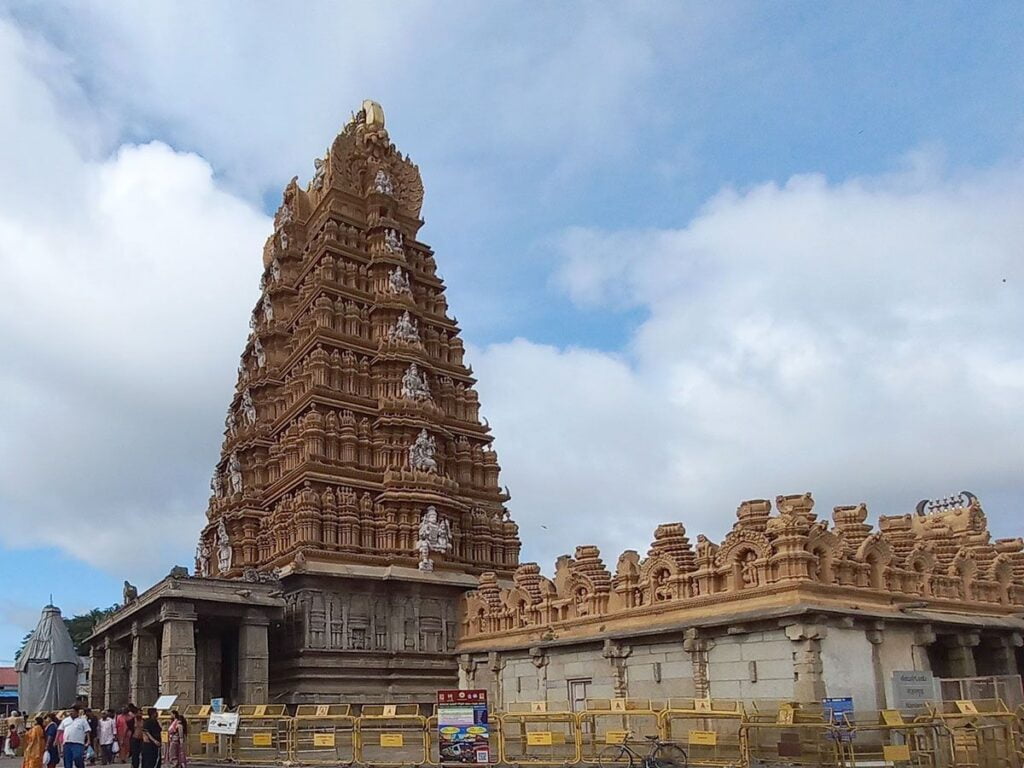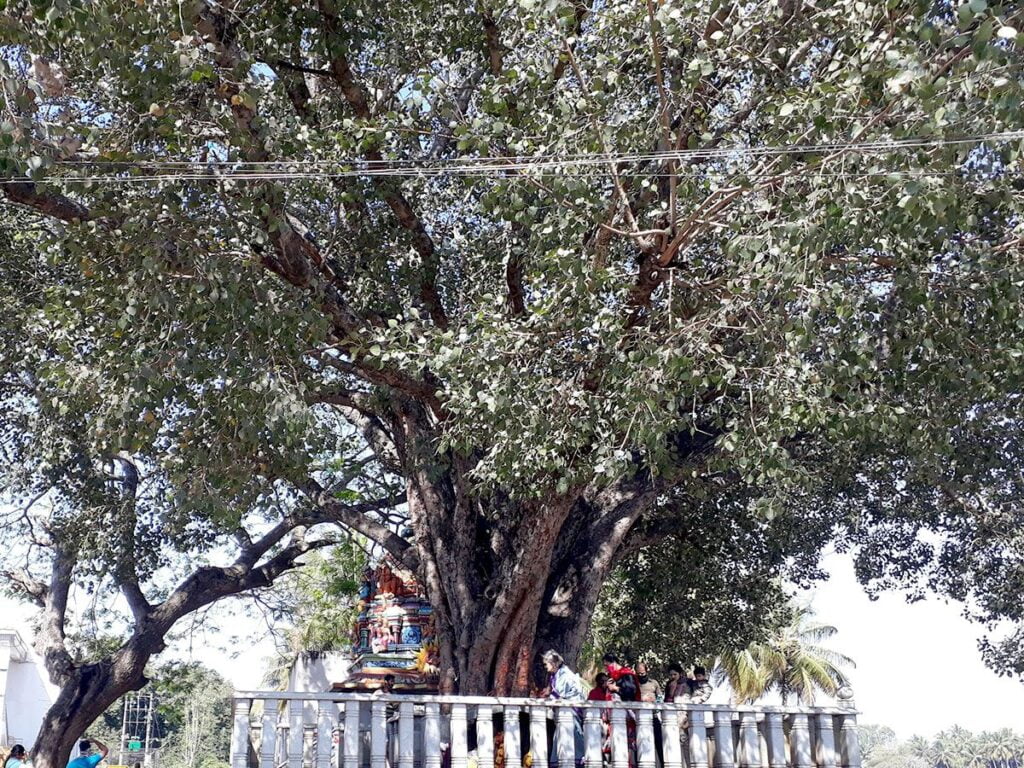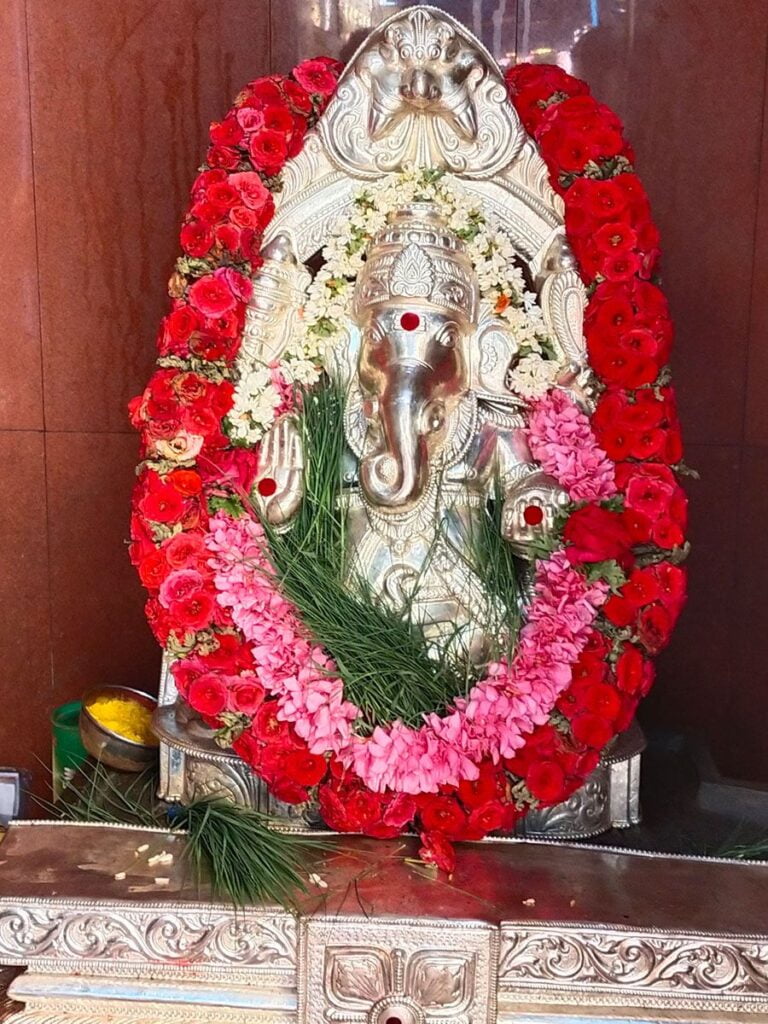Sri Nimishamba Temple Srirangapatna Mysore
The Nimishamba Temple Srirangapatna is a Hindu temple dedicated to the goddess Nimishamba, a form of the goddess Parvati. It is located in Srirangapatna, Karnataka, India, on the banks of the Kaveri River. The temple is about 2 kilometers from Srirangapatna town and 18 kilometers from Mysore.

Contents
- 1 History of Nimishamba Temple Srirangapatna:
- 2 Legend of Nimishamba Temple Srirangapatna:
- 3 Significance of Nimishamba Temple Srirangapatna:
- 4 Myths of Nimishamba Temple Srirangapatna:
- 5 Architecture of Nimishamba Temple Srirangapatna:
- 6 Nimishamba Temple Timing and Rituals:
- 7 Places to visit near Nimishamba Temple Srirangapatna:
- 8 FAQ:
- 9 How to reach Nimishamba Temple Srirangapatna:
- 10 Google Maps:
History of Nimishamba Temple Srirangapatna:
Founding and Age:
- The exact date of construction is unknown, but most sources point to the reign of Mummadi Krishnaraja Wodeyar (1610-1638 AD). This places its construction around 300-400 years ago.
- There’s a possibility the temple might have been built even earlier, during the reign of Raja Wadiyar I (1610–38 A.D.).
The name Nimishamba translates to “one minute”, stemming from the belief that the goddess answers devotees’ prayers within a minute.
Legend associates the temple with King Muktharaja, who performed penance here and carved the Sri Chakra on a stone, still housed in the temple.
The deity, Nimishamba, is considered a powerful incarnation of Parvati, the consort of Lord Shiva.
Varamahalakshmi festival and Durgashtami during Dussera are significant celebrations at the temple.
Read More>> Kotilingeshwara Temple Karnataka: 108 Ft Massive Lingam in the world

Legend of Nimishamba Temple Srirangapatna:
According to legend, Muktharaja was once engaged in a fierce battle with a demon named Kalasura. The battle raged for days, and Muktharaja was on the verge of defeat. In desperation, he turned to Nimishamba for help. The goddess appeared to him in a dream and promised him victory if he would build a temple in her honor.
Muktharaja agreed, and after he won the battle, he immediately began construction on the temple. The temple was completed in a remarkably short time, and it is said that the goddess herself helped with the construction.
The Nimishamba Temple is a beautiful and intricate structure, and it is said to be one of the most powerful temples in Karnataka. The temple is home to a number of sacred shrines, including a sanctum sanctorum that houses the idol of the goddess Nimishamba.
The temple is also home to a number of legends and stories, many of which are related to the goddess Nimishamba. It is said that the goddess is extremely powerful and that she can grant the wishes of her devotees.
The Nimishamba Temple is a popular pilgrimage site, and it is visited by thousands of people every year. The temple is a place of great spiritual significance, and it is said that those who visit the temple with a pure heart will be blessed by the goddess Nimishamba.
Here are some of the legends associated with the Nimishamba Temple:
- It is said that the goddess Nimishamba appeared to Muktharaja in a dream and promised him victory in battle if he would build a temple in her honor.
- The temple is said to have been built in a remarkably short time, with the goddess herself helping with the construction.
- The temple is home to a number of sacred shrines, including a sanctum sanctorum that houses the idol of the goddess Nimishamba.
- The goddess Nimishamba is said to be extremely powerful and that she can grant the wishes of her devotees.
- The Nimishamba Temple is a popular pilgrimage site, and it is visited by thousands of people every year.
- The temple is a place of great spiritual significance, and it is said that those who visit the temple with a pure heart will be blessed by the goddess Nimishamba.
Read More>> Shri Kalabhairaveshwara Temple Bengaluru

Significance of Nimishamba Temple Srirangapatna:
Religious Importance:
- Dedicated to Goddess Parvati: The temple is dedicated to Goddess Nimishamba, considered an incarnation of Goddess Parvati, consort of Lord Shiva.
- Wish-fulfilling deity: Devotees believe Nimishamba grants wishes quickly, often within a “nimisha” (a blink of an eye), hence the name.
- Epitome of forgiveness: She is revered for her compassionate nature and ability to remove troubles and obstacles.
- Shiva connection: The temple also houses a Shiva lingam, representing Lord Shiva, further adding to its spiritual significance.
Historical Significance:
- Ancient origins: Estimated to be over 400 years old, built during the reign of Mummadi Krishnaraja Wodeyar.
- Royal connection: Its construction is attributed to the Mysore royal family, adding to its historical value.
- Cultural heritage: The temple represents Dravidian architecture and cultural heritage of the region.
Geographical Significance:
- Scenic location: Situated on the banks of the Cauvery river, offering a serene and peaceful atmosphere.
- Tourist attraction: Draws visitors from across the country and abroad, contributing to the local tourism industry.
Personal Significance:
- Devotional pilgrimage: Devotees seeking blessings, overcoming challenges, or finding peace visit the temple for solace and spiritual guidance.
- Community gathering: Serves as a place for religious ceremonies, celebrations, and community events.
Read More>> Shivoham Shiva Temple: 65 Foot Tall Statue of Lord Shiva

Myths of Nimishamba Temple Srirangapatna:
- The Goddess Nimishamba is said to have appeared to a sage named Agastya in a dream. In the dream, she told him to build a temple for her on the banks of the Cauvery River. Agastya did as he was told, and the temple was built.
- The Goddess Nimishamba is said to be able to grant wishes. This is why the temple is a popular pilgrimage destination for people who are seeking blessings from the goddess.
- The Goddess Nimishamba is said to be able to protect her devotees from harm. This is why many people wear amulets or talismans with the goddess’s image on them.
- The Goddess Nimishamba is said to be able to cure diseases. This is why many people come to the temple to pray for healing.
Read More>> 7th Century Virupaksha Temple Hampi
Architecture of Nimishamba Temple Srirangapatna:
Simple yet Elegant:
The Nimishamba Temple boasts a relatively simple yet elegant architectural style. While not as intricately adorned as some South Indian temples, it exudes a serene and peaceful charm.
Entrance and Rajagopuram:
As you approach the temple, you’ll be greeted by two statues of Goddesses Saraswati and Lakshmi flanking the entrance. Above the entrance stands the majestic seven-tiered gopuram, the gateway tower that is a characteristic feature of South Indian temple architecture.
Sanctum and Deities:
The temple’s sanctum sanctorum houses the main idol of Goddess Nimishamba, believed to be a reincarnation of Parvati, the consort of Lord Shiva. The sanctum also enshrines Lord Shiva under the name Moukthikeshwara and Lord Lakshminarayana.
Other Features:
- A “Sri Chakra,” a sacred geometric symbol representing the universe, is intricately carved into a stone slab in front of the Nimishamba idol.
- The temple’s walls are adorned with simple yet beautiful sculptures and carvings depicting various deities and mythological stories.
- A large bronze bell hangs from the ceiling, rung by the high priest at specific times during the day.
- The temple complex also includes a small mandapa, or pillared hall, and a serene courtyard.
Read More>> Hasanamba Temple: Stone Sleeps & Spirit Awakes

Nimishamba Temple Timing and Rituals:
Timings:
- General Darshan: 6:30 AM to 8:30 PM
- Maha Naivedhya: 12:00 PM
- Pradoshakaala Abhisheka: 6:30 PM to 7:30 PM (Excluding Sundays, Fridays, Full Moon days, New Moon days, and Government Holidays)
- Special Days: 4:00 AM to 6:30 AM
- Every Full Moon: 5:00 AM to 8:30 AM
Rituals:
- Abhisheka: This is a священное bathing ritual performed on the deities with various священные substances like milk, water, panchamruta, etc. It is believed to be very auspicious and can bring blessings to the devotees.
- Pooja: This is a form of worship that involves offering prayers, flowers, incense, and other священные items to the deities. There are different types of pujas performed at the Nimishamba Temple, each with its own specific purpose.
- Homa: This is a fire ritual where священные offerings are made to the deities. It is believed to be a very powerful way to connect with the divine and seek blessings.
- Annadana: This is the सेवा of offering free food to the devotees.
Read More>> Murudeshwar Temple Karnataka: India’s 2nd Massive Shiva Statue
Special Festivals:
- Nimishambha Jayanthi: This is the main festival of the temple, celebrated on Vaishakha Shudha Dashami. It features various homas and rituals, including Ganapathi Homa, Nimishambha Homa, Mruthyunjaya Homa, and Lakshminaryana Homa. An Abhisheka Pooja with 108 kalasas is performed for the main deities. There is also an evening procession of Shree Nimishambha Devi, Moukthikeswara, and Narayanaswamy.
- Durga Homa: This involves chanting the moolamantra of Goddess Durga 1008 times. Japa is done by chanting the moolamantra 108 times. Rituals include Aachamana, Devata Praarthane, Mahasankalpa, Ganapati Pooje, Punya, Kalasha Pooje, Durga Homa, and Paayasam Offerings.
Places to visit near Nimishamba Temple Srirangapatna:
- Ranganatha Swamy Temple: The main attraction in Srirangapatna is the Ranganatha Swamy Temple. It’s a Hindu temple dedicated to Lord Ranganatha, an incarnation of Lord Vishnu. The temple has a unique reclining posture of Lord Vishnu.
- Colonel Bailey’s Dungeon: This historical site is associated with the captivity of Colonel Bailey during the Fourth Anglo-Mysore War. The dungeon is an underground chamber where prisoners were held.
- Gumbaz Mausoleum: Built by Tipu Sultan, Gumbaz is the final resting place of Tipu Sultan, his father Hyder Ali, and his mother Fakr-un-Nisa. The mausoleum has a large dome and beautiful gardens.
- Karighatta Viewpoint: Located a short distance from Srirangapatna, Karighatta offers panoramic views of the surrounding landscape. It’s a serene spot with a temple and steps leading down to the river.
- Mysore Palace (Amba Vilas Palace): In Mysore, visit the Mysore Palace, a stunning example of Indo-Saracenic architecture. The palace is illuminated on Sundays and during the Dasara festival.
- Chamundi Hills: Climb up the Chamundi Hills to visit the Chamundeshwari Temple. The panoramic view of Mysore from the top is breathtaking.
- Jaganmohan Palace Art Gallery and Auditorium: This palace has an extensive collection of paintings, sculptures, and musical instruments. It’s an excellent place for art enthusiasts.
- St. Philomena’s Church: A magnificent Neo-Gothic style church in Mysore, St. Philomena’s Church is one of the largest churches in India.
- Mysore Zoo: Sri Chamarajendra Zoological Gardens, commonly known as Mysore Zoo, is one of the oldest and most popular zoos in India.
- Brindavan Gardens: Located near the Krishnarajasagara Dam, the Brindavan Gardens is famous for its musical fountain, colorful lights, and well-maintained gardens.
FAQ:
History
- When was the Nimishamba Temple built?
The Nimishamba Temple was built in the 7th century AD by the Chalukya dynasty.
- Who is the main deity of the Nimishamba Temple?
The main deity of the Nimishamba Temple is Goddess Nimishamba, a form of the Hindu goddess Parvati.
- What is the significance of the Nimishamba Temple?
The Nimishamba Temple is one of the most important pilgrimage sites in Karnataka. It is believed that the goddess Nimishamba can grant wishes and solve problems.
Architecture
- What is the architectural style of the Nimishamba Temple?
The Nimishamba Temple is built in the Dravidian style of architecture.
- What are the main features of the Nimishamba Temple?
The main features of the Nimishamba Temple include the gopuram (gateway tower), the mandapam (hall), and the sanctum sanctorum.
- What are the sculptures and carvings in the Nimishamba Temple?
The Nimishamba Temple is decorated with a variety of sculptures and carvings, including depictions of gods, goddesses, and mythical creatures.
Visiting the Nimishamba Temple
- How to get to the Nimishamba Temple?
The Nimishamba Temple is located in Srirangapatna, Karnataka, India. It is about 18 kilometers from Mysore.
- What are the timings of the Nimishamba Temple?
The Nimishamba Temple is open from 6:30 AM to 12:30 PM and from 4:00 PM to 8:30 PM.
- What are the festivals celebrated at the Nimishamba Temple?
The main festivals celebrated at the Nimishamba Temple are the Navratri festival and the Mahashivratri festival.
- What are the facilities available at the Nimishamba Temple?
The Nimishamba Temple has a number of facilities for visitors, including a cloakroom, a shoe stand, and a prasadam (offering) counter.
Tips for visiting the Nimishamba Temple
- Dress modestly when visiting the Nimishamba Temple.
- Photography is not allowed inside the Nimishamba Temple.
- There is no entrance fee to visit the Nimishamba Temple.
- It is customary to offer a donation to the temple.
How to reach Nimishamba Temple Srirangapatna:
By Road:
- Private Vehicle/Car:
- Srirangapatna is approximately 15 kilometers from Mysore, and the journey takes around 30 minutes, depending on traffic conditions.
- You can drive your private vehicle or hire a taxi/cab to reach Srirangapatna.
- Bus:
- Karnataka State Road Transport Corporation (KSRTC) operates buses between Mysore and Srirangapatna.
- You can board a bus from the Mysore City Bus Stand or inquire at local bus terminals for the schedule.
By Train:
- Train:
- There is no direct train station in Srirangapatna. The nearest major railway station is in Mysore.
- After reaching Mysore Railway Station, you can hire a taxi or use local transportation to reach Srirangapatna.
By Air:
- Air:
- The nearest airport is Mysore Airport (MYS), which is well-connected to major cities in India.
- After reaching Mysore Airport, you can hire a taxi or use other local transportation to reach Srirangapatna.

One Comment